Organic geochemical characteristics of Eocene crude oils from Zhanhua Depression, Bohai Bay Basin, China
2020-11-10YujiaoZhangHongLuYaoPingWangXinZhanPinganPeng
Yujiao Zhang · Hong Lu · Yao-Ping Wang · Xin Zhan · Ping’an Peng
Abstract Geochemical studies of crude oil and source rock play an important role in future exploration in Zhanhua Depression. In this study, thirty-one oil samples collected from Shahejie Formation in Zhanhua Depression,Bohai Bay Basin, NE China have been geochemically analyzed and their organic geochemical characteristics have been applied to differentiate groups of oils.These oil samples can be classified into two families based on multiple biomarker proxies and stable carbon isotopic values.Family I is characterized by a low ratio of pristane over phytane (Pr/Ph <0.7), a relatively high ratio of phytane over n-C18(Ph/n-C18),varying ratios of gammacerane over C30 hopane(Ga/C30H)and C22/C21 tricyclic terpane,and a low ratio of C19/C23 tricyclic terpane. Family II is marked by a relatively high Pr/Ph ratio (0.7-1.6), relative low ratios of Ph/n-C18 and C22/C21 tricyclic terpane, and avarying ratio of C19/C23 tricyclic terpane. Both families I and II within these crude oils can be subdivided into two families based on different values of stable carbon isotopic composition of individual n-alkanes. Moreover, the potential source rocks of oil samples in Family I and Family II were likely derived from the upper Es4 member and Es3 member, respectively, based on the correlation of organic geochemical characteristics of the oils and source rocks. The results of oil-source rock correlation provide insight into the process from oil generation to migration and to final accumulation,providing a better understanding of factors controlling oil-gas distribution for prediction of sweet spots.
Keywords Zhanhua depression · Bohai Bay Basin ·Biomarkers · Stable carbon isotopic compositions · Crude oil
1 Introduction
A key problem in the oil-source study is to distinguish the effects of source on oil compositions, including organic matter input, depositional environment, and thermal maturity(Peters et al.2005).Biomarkers are widely used in identifying groups of genetically related oils and correlating oils with source rocks (Moldowan et al. 1985; Peters et al.2005).Their distributions and parameters can be used to interpret the depositional conditions and describe the source rock of migrated oil of uncertain origin(Seifert and Moldowan 1978, 1981). Variations in specific biomarker parameters are controlled by source input,such asn-C15,n-C17,n-C19versusn-C25,n-C27,n-C29(Bourbonniere and Meyers 1996)and the abundance of 4-methylsteranes(Bird et al.1971;Wolff et al.1986;Volkman et al.1990);others are dominated by maturity, such as 22S/(22S+ 22R)homohopane isomerization (Seifert and Moldowan 1980)and moretane/hopanes (Mackenzie et al. 1980; Seifert and Moldowan 1980); some others are affected by both source and maturity,such as diasteranes/steranes(Rubinstein et al.1975; Sieskind et al. 1979; Mello et al. 1988).
While carbon isotope analysis of bulk fractions has been frequently used in oil-source rock correlation (e.g.,Rullkötter et al. 1986; Chung et al. 1997; Cai et al. 2015),compound-specific carbon isotope analysis of individual hydrocarbons has shown its advantage of accurate data and confidence in the interpretation of oil-oil and oil-source rock correlations (Freeman et al. 1990; Hayes et al. 1990;Bjorøy et al.1991,1994;Bakel et al.1993;Boreham et al.1995; Odden et al. 2002).
The Zhanhua Depression is located in the northeastern Jiyang sub-basin,Bohai Bay Basin,eastern China(Fig. 1).Intensive petroleum exploration suggests that the petroleum reserves were more than 19.1 × 108t(Li et al.2017;Yuan et al. 2019). Shengli oil field is one of the primary oil-gas fields in China. As a highly explored area, the Zhanhua Depression area has stepped into the exploration stage of subtle reservoirs. However, the origin of oil and gas has remained as the focus. In previous geochemical studies of oil-source correlations in Zhanhua (e.g., Shi et al. 2005; Wang 2011; Song and Men 2019), compoundspecific isotopic data was rarely reported compared to the biomarker. This study investigates both biomarkers and stable carbon isotopic compositions ofn-alkanes from oils in Zhanhua Depression. In addition, most geochemical studies of oils from Zhanhua Depression (e.g., Gong et al.2005; Liu et al. 2006a, b; Zhang et al. 2006) have limited oil samples from single well or source rock of a single member. This study investigates the geochemical characteristics of oils in Es1-4members from multiple wells in Zhanhua Depression. Two families of oils are classified and further subdivided on the basis of biomarker and carbon isotopic proxies. The original strata and the distribution of oils and gas from different source rocks are interpreted through fine oil-source rock correlation on the basis of the geochemical characteristic of crude oil and source rock. This study provides effective methods on the division of oil-gas systems and the prediction of oil-gas migration. A better understanding of these controlling factors, with the synthesis of local geological information(e.g., structure and fault), assist in the promotion of oil production in existed wells and contributes new evidence and supplements to future exploration of oils in Zhanhua Depression. This comprehensive study combined biomarkers and compound-specific carbon isotopic data and provided insight into possible origins of the two oil families, in order to provide helpful recognitions and progress of oil-source rock correlation, which provides new evidence and supplements to the previous study of Zhanhua Depression.
2 Samples and methods
2.1 Geological settings
Zhanhua Depression is one of the seven individually developed depressions in the Bohai Bay Basin (Fig. 1b;Zhang et al. 2005). Chenjiazhuang Uplift is in the South and Yihezhuang Uplift is in the north of Zhanhua Depression (Fig. 1c; Liu et al. 2006a, b; Li et al. 2017). It forms a typical half-graben rift basin whose north side is faulted, and south side overlapped, covering an area of 2800 km2(Ma 2017).
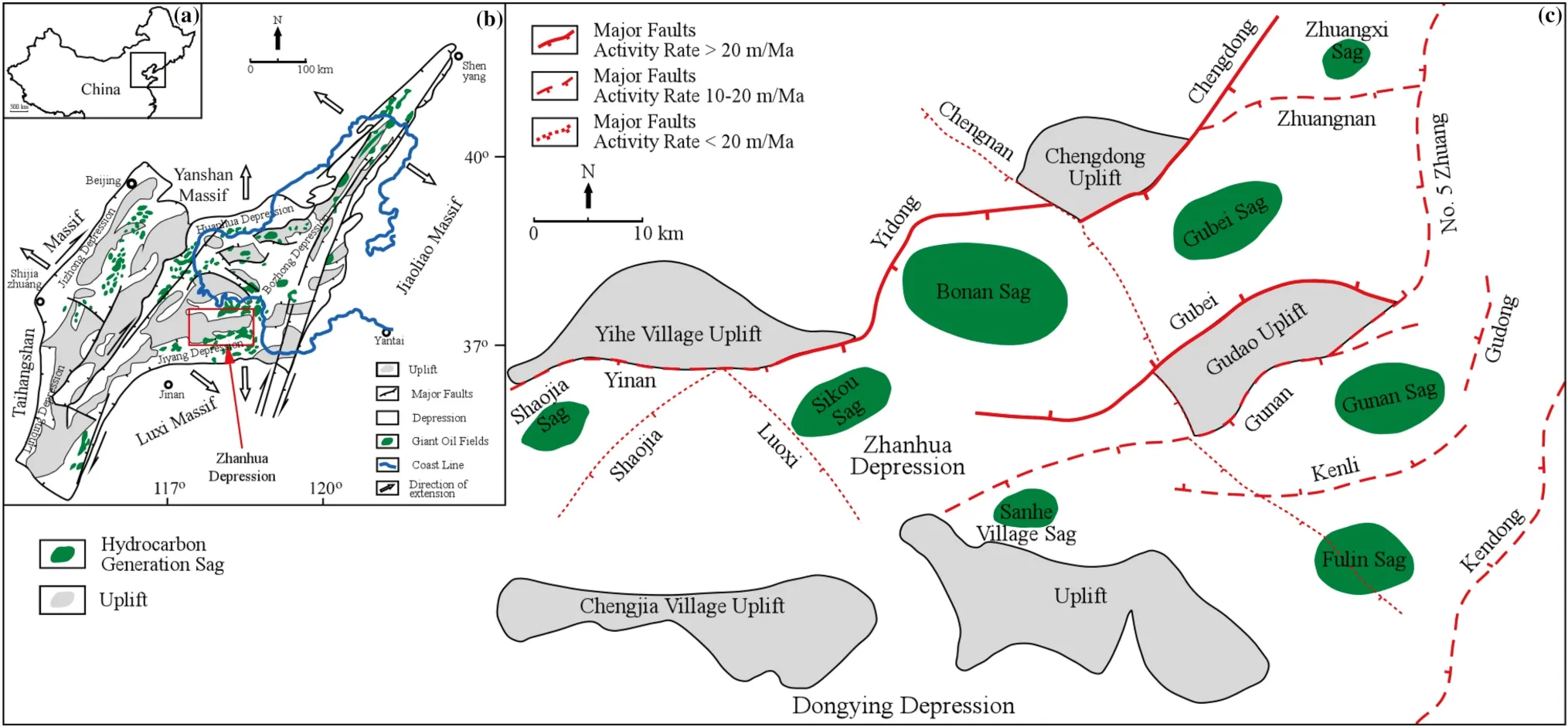
Fig. 1 Location of the study area:Maps show the elementary structural features of Zhanhua Depression(Modified from Ma 2017):Location of the Bohai Bay Basin in China(a),subbasins of the Bohai Bay Basin(b),location map showing the distribution of hydrocarbon generation sags in Zhanhua depression (c)
The lacustrine deposits in Zhanhua Depression comprise three Paleogene units: Kongdian (Ek), Shahejie (Es), and Dongying (Ed) Formations (Liu 2017). The Shahejie Formationis subdivided into four members: Es1, Es2, Es3, and Es4in descending order(Fig. 2).The potential source rocks are considered located in the upper Es4, Es3, and Es1members(Shi et al.2005;Song and Men 2019).The lower Es4comprises mudstone with anhydrate and salt while the upper Es4contains laminated oil shale and lime mudstone with carbonate, interpreted as saline lake deposits during lake contraction (Liu 2017; Song and Men 2019). The lower Es3has thick laminated shale and calcareous shale with intercalated siltstone while the middle-upper Es3is composed of thick massive siltstone and sandy siltstone,suggesting a transition from salt-brackish lake to the fresh lake during lake expansion(Zhu 2002;Ma et al.2016;Liu 2017). Es2has mudstone with intercalated sandstone and conglomerate, representing fluvial-deltaic deposits during lake contraction(Allen et al.1997;Zhu 2002).Es1contains thick laminated shale, mudstone, sandstone, and thin biogenic carbonates, interpreted as profundal deposits during lake expansion (Zhu 2002; Song and Men 2019).
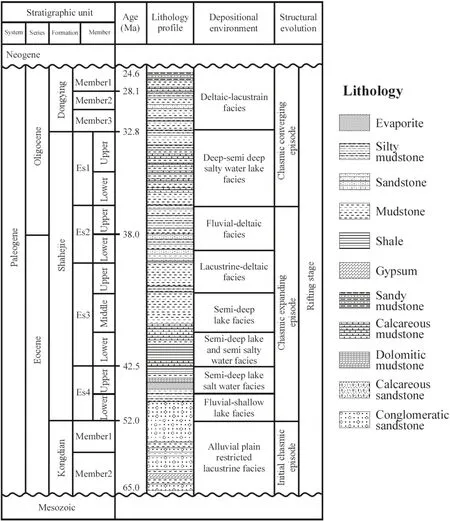
Fig. 2 Tertiary stratigraphy of the Zhanhua Depression (Modified after from Jiu et al. 2013)
2.2 Samples
Forty-eight crude oil samples in Shahejie Formation have been collected from reservoirs in multiple drilling wells in Zhanhua Depression, Bohai Bay Basin. Highly biodegraded oils have been excluded because the secondary alteration process may have caused variations on type and abundance of biomarkers in these oils, result in misinterpretation of the oil-source relationship (Peters et al. 2007;2016). Thus, the remaining thirty-one oil samples without biodegradation have been selected and analyzed in this study.
2.3 Methods
The oils were dissolved inn-hexane and ultrasonicated,the soluble fraction was further separated into saturated, aromatic,and polar fractions on a silica/alumina column using hexane, hexane/dichloromethane (3:2), and methanol,respectively.The saturated fraction was further treated with urea adduction to yield the branched and linear chain alkane fractions, and each fraction was conducted on GCIRMS for compound-specific isotope analysis.
GC/MS analysis was performed on a Trace Ultra GC coupled to a Thermo DSQ-II mass spectrometer operated at an ionization energy of 70 eV with a full scan ranging fromm/z50-600. An HP-5 fused silica capillary column(30 m × 0.25 mm i.d. × 0.25 μm film thickness) was used. The GC oven temperature was set initially at 80 °C and held for 2 min, then increased to 295 °C at a heating rate of 3 °C/min and held for 20 min.High purity nitrogen was used as the carrier gas with a constant flow of 1.2 mL/min.
GC-IRMS analysis was performed on the saturated hydrocarbon fractions for compound-specific carbon isotopic measurements, using an Isoprime IRMS instrument interfaced to an HP6890 GC instrument via a combustion interface. A DB-5 column (30 m × 0.32 mm i.d. × 0.25 μm film thickness) was used for chromatographic separation. The GC oven was increased from 80 to 300 °C at a heating rate of 4 °C/min and held for 30 min.Each sample was analyzed in triplicate, and the average value for the three runs was regarded as the final δ13C value of the sample. Isotope ratios are determined based on delta notation(‰)relative to the Vienna Pee Dee Belemnite(VPDB) standard. The precision of replicated samples is better than ± 0.08 ‰ for the compound-specific carbon isotopic measurements.
3 Results and discussion
3.1 Molecular geochemistry
3.1.1 n-alkanes and acyclic isoprenoids
Then-alkane distribution of oils collected in Es1and Es3-members are quite similar (Fig. 3a; Table 1).n-alkanes in most oil samples have a predominance of medium molecular weight compounds (n-C19-25)and arrange fromn-C13ton-C33, with only a few of them, containn-C34-37, suggesting weak biodegradation. Oils from Es2and Es4members are generally dominated by both low (n-C18-20)and high(n-C28-30)molecular weight compounds(Fig. 3b;Table 1),suggesting a major source contribution from both algae and terrestrial higher plants into organic matter(Peters et al. 2005).
The Pr/Ph ratios of the oil samples range between 0.25 and 1.59. The oils from Es1and Es3members are commonly marked by a weak dominance of pristane over phytane,with an average Pr/Ph ratio of 1.23,suggesting the source rock of the oils were likely deposited in sub-oxic conditions (Didyk et al. 1978). Oils from Es2and Es4members have a pronounced predominance of phytane over pristane, with an average Pr/Ph ratio of 0.39, indicating the oils were derived from source rocks deposited in reducing conditions. According to the ternary diagram of Pr/Ph-Pr/n-C17-Ph/n-C18(Fig. 4a), source rocks of oils from Es2and Es4were likely deposited in brackish-saline water environment and almost source rocks of oils from Es1and Es3members likely formed in freshwater. This is consistent with the high phytane/n-C18ratios of oils from Es1and Es3compared with that of oils from Es2and Es4members. A crossplot of Pr/nC17versus Ph/nC18can be used to indicate thermal maturity as well as the depositional environment and the organic matter type of the source rock(Peters et al.1999;Hanson et al.2001).The Pr/nC17versus Ph/nC18results suggest the source rocks of oils from Es2and Es4members mainly developed in algal and reducing environment, while that of oils from Es1and Es3members developed in a transitional environment with mixed organic matter of algae and terrestrial higher plants(Fig. 4b).
3.1.2 Terpenoids
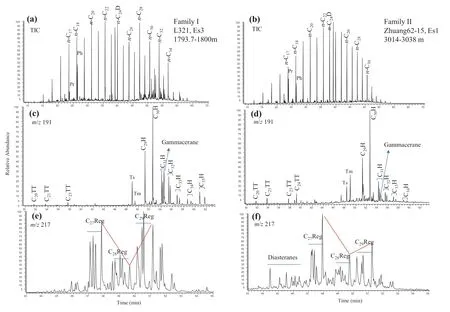
Fig. 3 Representative mass chromatograms of total ion chromatogram (TIC), hopane (m/z 191) and sterane (m/z 217) series of saturated hydrocarbon fraction for crude oils in the Zhanhua Depression
Terpanes are identified using GC/MS by monitoring the ionsm/z191 (Fig. 3c, d).The C19-C20tricyclic terpanes(TTs) have been considered originated mainly from diterpenids (Peters et al. 2005), which are produced by vascular plants(Peters et al.2005).Marine and saline water conditions promote the generation of C23TTs (Neto et al.1981; Tao et al. 2015; Chen et al. 2017), whereas C23TTs are dominated in freshwater(Zhu 1997).Therefore,carbon number distributions of the TTs are considered a useful indicator of organic matter input and environmental conditions (Peters et al. 2005; Xiao et al. 2019). C19/C23TTs ratio ranges from 0.09 to 0.45 in all oil samples,suggesting varying organic matter input and environmental conditions.
Hopanes, derived from membranes of aerobic bacteria and photosynthetic cyanobacteria (Ourisson and Albrecht 1992),have been widely used as proxies for organic matter input, depositional environments, and thermal maturity level (Peters et al. 2005).C2718α-trisnorneohopane (Ts) is thermally more stable than the C2717α-trisnorhopane(Tm)during catagenesis (Seifert and Moldowan 1978). The investigated oils have a wide range of Ts/(Ts + Tm)ratios ranging from 0.09 to 0.47, suggesting the presence of multiple groups of crude oils with different maturities(Moldowan et al. 1985) or diverse source depositional environments (Peters et al. 2005).
The distribution of the homohopanes(C31-C35)has been used to evaluate redox conditions based on homohopanes index (Peters et al. 2005). High C35/C34homohopanes ratios of oil samples from Es4range from 1.15 to 2.61 while the low C35/C34homohopanes ratios (0.42-0.90) in Es1-3are lower than 1 except two samples in Es3suggesting source rocks of the oils in Es4were deposited in highly reducing conditions and that in Es1-3were deposited in suboxic conditions (Moldowan et al. 1985; Peters and Moldowan 1991). This is consistent with interpretation from low Pr/Ph ratios of oil samples.
High abundance of gammacerane is typically related to highly reducing and hypersaline conditions during the deposition of organic matter (Damsté et al. 1995; Peters et al. 2005; Summons et al. 2008; Albaghdady 2013). The average ratios of gammacerane to C30hopane(Ga/C30H)of oil samples from Es2(0.34) and Es4(0.21) are higher than that of Es1(0.16)and Es3(0.12),suggesting source rocks of oils from Es2and Es4were likely deposited in the brackishsaline lake and that from Es1and Es3were deposited in fresh-water lake conditions.
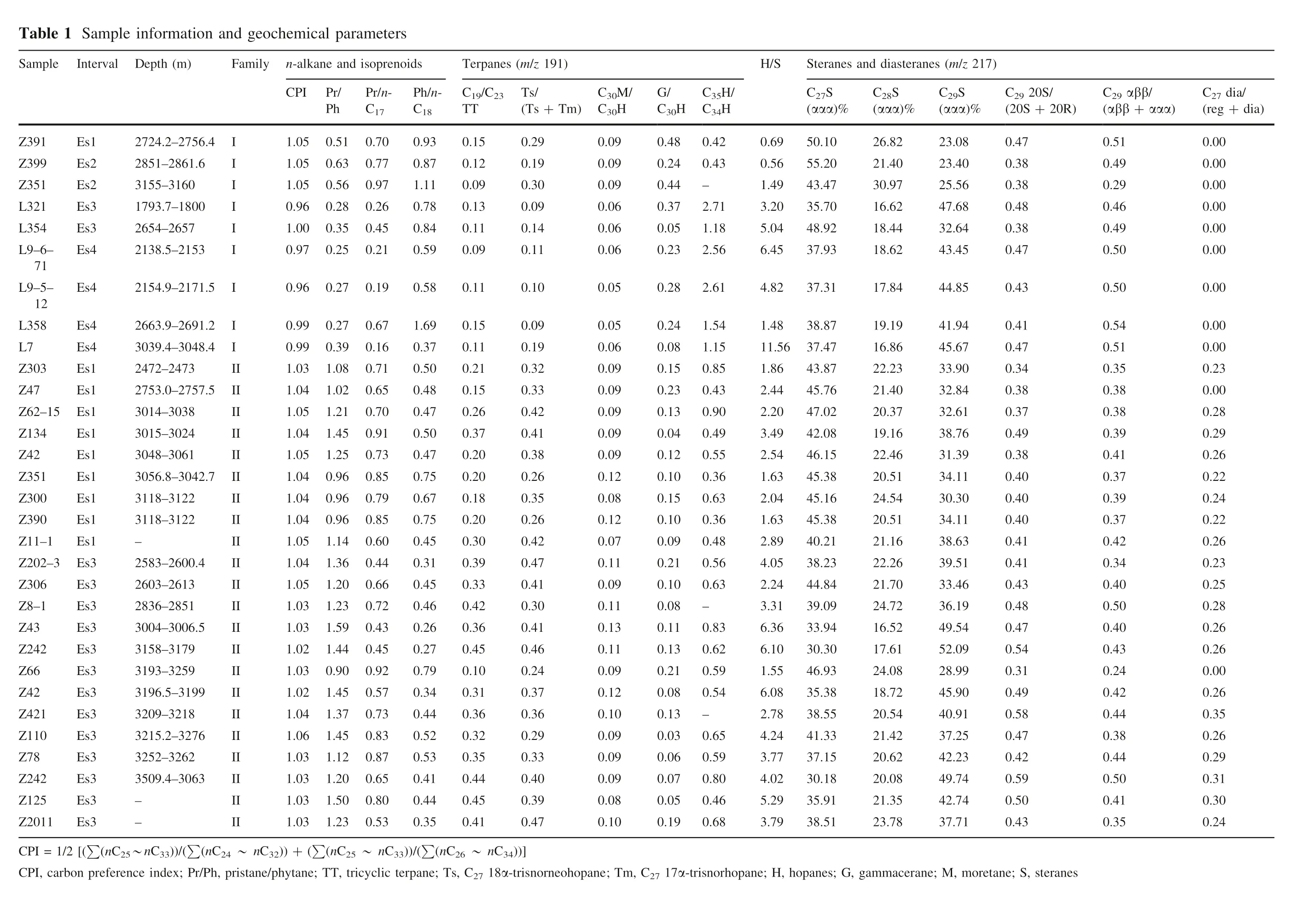
C27 d ia/dia)(reg +0.00 0.00 0.00 0.00 0.00 0.00 0.00 0.00 0.00 0.23 0.00 0.28 0.29 0.26 ββ/αα α)9 αC2(α ββ +0.51 0.49 0.29 0.46 0.49 0.50 0.50 0.54 0.51 0.35 0.38 0.38 0.39 0.22 0.24 0.22 0.26 0.23 0.25 0.28 0.26 0.26 0.00 0.26 0.35 0.26 0.29 0.31 0.30 0.24 0.41)/C29 20S(20S+ 20R 0.47 0.38 0.38 0.48 0.38 0.47 0.43 0.41 0.47 0.34 0.38 0.37 0.49 0.37 0.39 0.37 0.42 0.34 0.40 0.50 0.40 0.43 0.24 0.42 0.44 0.38 0.44 0.50 0.41 0.35 0.38 iasteranes (m/z 2 17)C2 9S(α αα)%23.08 23.40 25.56 47.68 32.64 43.45 44.85 41.94 45.67 33.90 32.84 32.61 38.76 0.40 0.40 0.40 0.41 0.41 0.43 0.48 0.47 0.54 0.31 0.49 0.58 0.47 0.42 0.59 0.50 0.43 e; S, steranesoretan 31.39 Steranes and d C28S(α αα)%26.82 21.40 30.97 16.62 18.44 18.62 17.84 19.19 16.86 22.23 21.40 20.37 19.16 34.11 30.30 34.11 38.63 39.51 33.46 36.19 49.54 52.09 28.99 45.90 40.91 37.25 42.23 49.74 42.74 37.71, m 22.46 7S 007023177628 20.51 24.54 20.51 21.16 22.26 21.70 24.72 16.52 17.61 24.08 18.72 20.54 21.42 20.62 20.08 21.35 23.78 m acerane; Mam, g 5 C2αα)%(α50.1 55.2 43.4 35.7 48.9 37.9 37.3 38.8 43.8 45.7 47.0 42.086813494038535811 46.1 H/S0.69 0.56 1.49 3.20 5.04 6.45 4.82 1.48 11.5 6 37.47 1.86 2.44 2.20 3.49 45.3 45.1 45.3 40.2 38.2 44.8 39.0 33.9 30.3 46.9 35.3 38.5 41.3 37.1 30.1 35.9 38.5es; G 2.54/C3 5H C3 4H 0.42 0.43-2.71 1.18 2.56 2.61 1.54 1.15 0.85 0.43 0.90 0.49 1.63 2.04 1.63 2.89 4.05 2.24 3.31 6.36 6.10 1.55 6.08 2.78 4.24 3.77 4.02 5.29 3.79, hopan pane; H 0.55 G/C3 0H 0.48 0.24 0.44 0.37 0.05 0.23 0.28 0.24 0.08 0.15 0.23 0.13 0.04 0.36 0.63 0.36 0.48 0.56 0.63-0.83 0.62 0.59 0.54-0.65 0.59 0.80 0.46 0.68 0.12/C3 0M C3 0H 0.09 0.09 0.09 0.06 0.06 0.06 0.05 0.05 0.06 0.09 0.09 0.09 0.09 0.10 0.15 0.10 0.09 0.21 0.10 0.08 0.11 0.13 0.21 0.08 0.13 0.03 0.06 0.07 0.05 0.19 m, C27 17α-trisnorho 0.09))Tm anes (m/z 1 91 Ts/(T s +0.29 0.19 0.30 0.09 0.14 0.11 0.10 0.09 0.19 0.32 0.33 0.42 0.41 0.12 0.08 0.12 0.07 0.11 0.09 0.11 0.13 0.11 0.09 0.12 0.10 0.09 0.09 0.09 0.08 0.10 e; T 0.38 3 Terp C19/C2 TT 0.15 0.12 0.09 0.13 0.11 0.09 0.11 0.15 0.11 0.21 0.15 0.26 0.37 0.26 0.35 0.26 0.42 0.47 0.41 0.30 0.41 0.46 0.24 0.37 0.36 0.29 0.33 0.40 0.39 0.47 8α-trisn orneohopan 0.20 oids /n-Ph C18 0.93 0.87 1.11 0.78 0.84 0.59 0.58 1.69 0.37 0.50 0.48 0.47 0.50 0.20 0.18 0.20 0.30 0.39 0.33 0.42 0.36 0.45 0.10 0.31 0.36 0.32 0.35 0.44 0.45 0.41(nC26 ~nC34))]s, C27 1 0.47 etersical param ane and iso pren Pr/n-C17 0.70 0.77 0.97 0.26 0.45 0.21 0.19 0.67 0.16 0.71 0.65 0.70 0.91 0.75 0.67 0.75 0.45 0.31 0.45 0.46 0.26 0.27 0.79 0.34 0.44 0.52 0.53 0.41 0.44 0.35∑0.73 r/Ph 0.51 0.63 0.56 0.28 0.35 0.25 0.27 0.27 0.39 1.08 1.02 1.21 1.45 0.85 0.79 0.85 0.60 0.44 0.66 0.72 0.43 0.45 0.92 0.57 0.73 0.83 0.87 0.65 0.80 0.53 5 ~nC33))/(1.25 chem Family n-alk CP I P 1.05 1.05 1.05 0.96 1.00 0.97 0.96 0.99 0.99 1.03 1.04 1.05 1.04 0.96 0.96 0.96 1.14 1.36 1.20 1.23 1.59 1.44 0.90 1.45 1.37 1.45 1.12 1.20 1.50 1.23(nC2 T, tricyclic terpane; T 1.05 and geo 6.4 I I I I I I II II II 1.04 1.04 1.04 1.05 1.04 1.05 1.03 1.03 1.02 1.03 1.02 1.04 1.06 1.03 1.03 1.03 1.03∑(e/phytane; T II ple information)031.5 I 1.2 I 8.4 I 7.5 II(m.2-2751.6 860 1665 7 47 303 802 42.7 II II II II II II II II II II II II II II II II II 4 ~nC32)) +, pristan 963(nC2 r/Ph 06 1 ep th 24-251-355.7-180-2.5-215.9-217.9-269.4-304-2.0-275-3-312 212 260 0.4 61 385 100 6.5 17 925 921 826 2∑ex; P-3 27283117 93 26 54 21 38 21 54 26 63 30 39 24 72 27 53 30 14 30 15.8-304-3-3-2-2-2-3-3-3.5-319-3.2-327-3.4-306 30 48 ble 1 S am Sample Interval D Es1Es2Es2Es3Es3Es4Es4Es4Es4Es1Es1s1Es1 30 56 31 18 31 188303360458939609155209-2526283031313132323235--5~nC33))/(Es1 Ta Z391 Z399 Z351 L321 L354 L9-6-71 L9-5-12 L358 L7Z303 Z47 Z62-15 E Z134 Es1Es1Es1Es1s3Es3Es3Es3Es3Es3Es3Es3Es3Es3Es3Es3Es3∑(nC21/2 [(reference ind Z42 Z351 Z300 Z390 Z11-1 Z202-3 E Z306 Z8-1 Z43 Z242 Z66 Z42 Z421 Z110 Z78 Z242 Z125 Z2011 CP I =CP I, carbon p
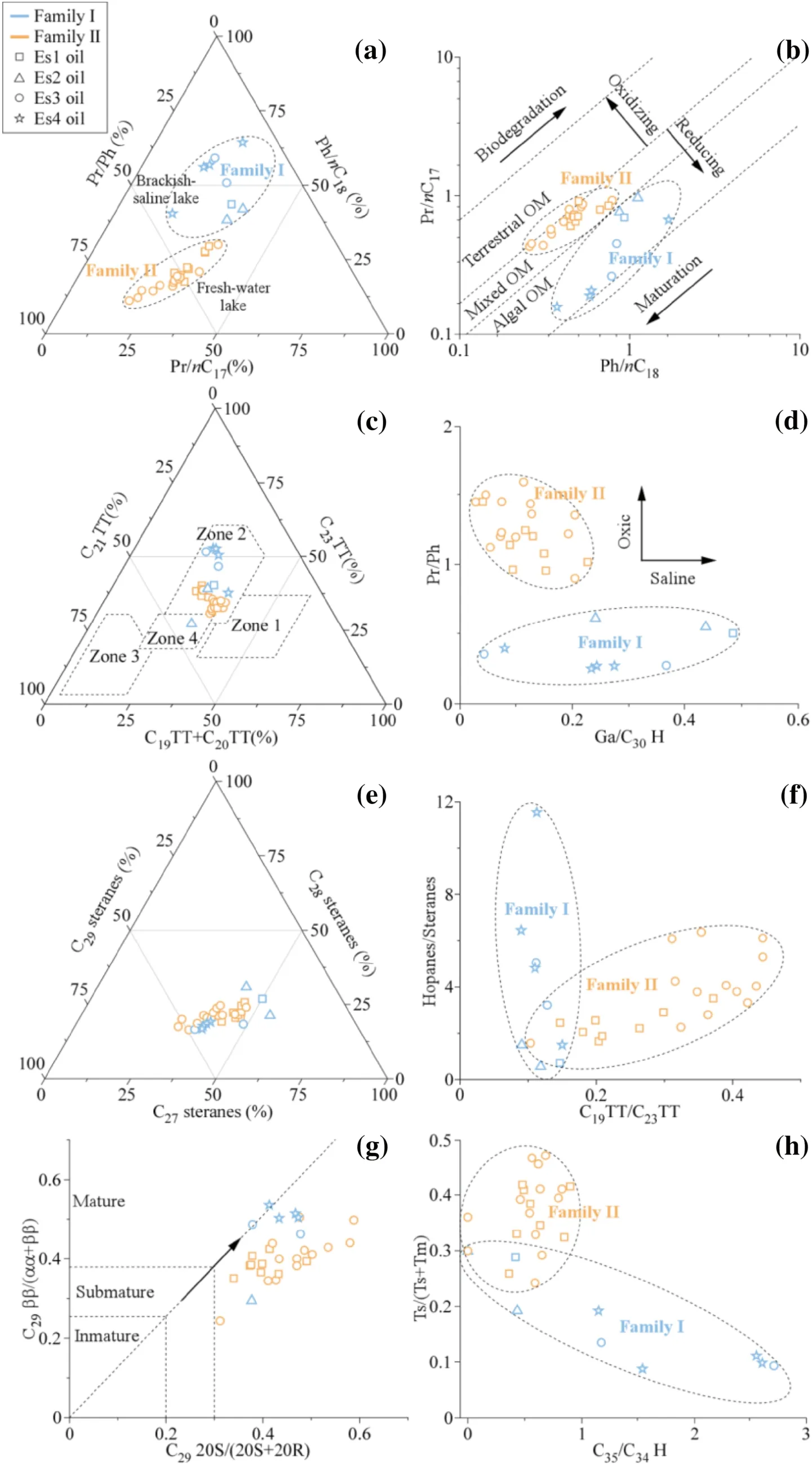
Fig. 4 Cross plots of geochemical parameters from oils discovered from different members of the Shahejie Formation in the Zhanhua Depression: Ternary plot showing the relationship between pristane/phytane,pristane/nC17 and phytane/nC18(a); Pristane/nC17 ratio versus phytane/nC18 ratio (b); Ternary plot showing the relationship between tricyclic terpanes C19 + C20, C21 and C23, Zone 1: marine and saline source rocks and oils; Zone 2: fresh water source rocks and oils;Zone 3: swamp source rocks and oils; Zone 4: fluvial/delta source rocks and oils (Zone 1-4 after Xiao et al. 2019) (c);Pristane/phytane ratio versus gammacerane/C30 hopane (d);Ternary plot showing the relative distribution of C27-C28-C29 steranes in the studied oils(e); Tricyclic terpane C19/C23 ratio versus Hopanes/Steranes(f); C29 sterane 20S/(20S + 20R) ratio versus C29 sterane αββ/(ααα + αββ) (g);Ts/(Ts + Tm) ratio versus C35/C34 homohopane ratio (h)
The ratio of C30moretane over C30hopane (C30M/C30H) is less than 0.15 in all samples. The C3017β,21α(H)-moretanes are thermally less stable than the C3017α, 21β(H)-hopanes and therefore the C30M/C30H value decreases with increasing thermal maturity (Peters et al.2005). Low C30M/C30H values of all the oil samples suggest that they are in moderate-high maturity. The ratio of the 22S/(22S+ 22R) for C3217α-hopane (C3222S/(22S+ 22R) Hopane) is in the range of 0.48-0.65, indicating the oils have reached equilibrium and are thermally mature (Mackenzie et al. 1984; Wang et al. 2018).
3.1.3 Steroids
The distributions of diasteranes and steranes are characterized by them/z217 in chromatograms (Fig. 3e, f). The proportions of regular C27-29steranes (%) have been used to indicate types of photosynthetic eukaryotes.C27steranes are mainly derived from algae,diatom,and zooplankton in lacustrine deposits, C28steranes are believed to be derived from lacustrine algae, while C29steranes typically constitute the sterols of vascular plants (Volkman 2003; Peters et al. 2005; Albaghdady 2013). The distribution of C27,C28, and C29ααα(20R) steranes is plotted on a ternary diagram (Fig. 4a). The dominance of both C27and C29steranes suggests a mixture of organic matter input from algae and terrestrial higher plants into the source rocks.
Diasteranes are present in oil samples from Es1and Es3,but not detected in the Es2and Es4members.The ratios of C27dia/(dia + reg sterane), defined as C27diasterane/(diasterane + regular sterane), range between 0.22 and 0.35 in the samples contain diasteranes. Regular steranes convert to diasteranes with thermal maturity or acidic catalysis in oxic and clay-rich conditions (Rubinstein et al. 1975).The values of C27dia/(dia + reg sterane) in oil samples from Es1and Es3may suggest moderate thermal maturity or suboxic and clay-poor conditions.
The hopane/sterane ratio ranges between 0.56 and 11.56,with an average value of 3.51 in all the oil samples. The hopane/sterane ratio is calculated as the sum of C27-3517αhopanes homologs over the sum of C27-29ααα(20S + 20R)and αββ(20S + 20R). The hopane/sterane ratio is generally used as an indicator of prokaryotic inputs versus eukaryotic inputs of organic matter into the source rocks(Ourisson and Albrecht 1992). The high value of hopane/sterane in all the oil samples suggests large input of bacterial organic matter or bacterial modification of organic matter.
Isomerization at C-20 in C295α, 14α, 17α-steranes causes an increase of 20S/(20S + 20R) ratio with increasing thermal maturity while isomerization at C-14 and C-17 in the C2920S and 20R regular steranes causes an increase of ββ/(ββ + αα) ratio with increasing thermal maturity (Seifert and Moldowan 1986).The ratios of C2920S/(20R+ 20S) and C29αββ/(ααα + αββ) steranes of all the oils are in the range of 0.34-0.59 and 0.61-0.85,indicating that the analyzed oils are thermally mature.
3.2 Oil family classification
The oils in this study are classified into two families and each of them is further subdivided into two groups based on biomarker and compound-specific carbon isotopic compositions. Families I and II have 9 and 22 oil samples,respectively.The Family I oils are mainly from Es2and Es4members of Shahejie Formation while Family II oils occur in the Es1and Es3reservoirs at diverse depths in oilfields in the Zhanhua Depression.
Family I is characterized by a low Pr/Ph value of 0.25-0.63 and a relatively high Ga/C30H ratio of 0.05-0.48(Fig. 4d). The Ph/n-C18ratio is higher than the Pr/n-C17ratio in the Family I oils (Fig. 4a). The ratio of hopanes/steranes in the Family I has a wide range between 0.56 and 11.56, whereas C19/C23tricyclic terpane has a narrow range between 0.09 and 0.15(Fig. 4f).Most samples in the Family I have a relatively higher abundance of C35homohopanes than that of C34homohopanes, with C35/C34homohopanes ratio of majority of samples larger than 1.0 (Fig. 4h). In addition, Ts/(Ts + Tm) values in the Family I are less than 0.3(Fig. 4h)and no diasteranes have been detected in the Family I oils.Family II is marked by a high Pr/Ph value in the range of 0.9-1.59 and a low Ga/C30H ratio of less than 0.23(Fig. 4d).The Ph/n-C18ratio is lower than the Pr/n-C17ratio in Family II (Fig. 4a, b).Moreover,the ratio of hopanes/steranes in Family II ranges from 1.55 to 6.36, whereas C19/C23tricyclic terpane has a wide range from 0.10 to 0.45 (Fig. 4f). Additionally, C35/C34homohopanes ratios of all oils in Family II are lower than 1 and Ts/(Ts + Tm) ratios of all oils in Family II are all higher than 0.2 (Fig. 4e). Diasteranes have been only detected in Family II; the ratios of C27diasterane/(diasterane + regular) steranes are in the range of 0.22-0.31(Table 1). Finally, C29sterane 20S/(20S+ 20R) ratios of oils in both Family I and II are higher than 0.3 and C29sterane αββ/(ααα + αββ) ratios of oils in both Family I and II are higher than 0.25 (Fig. 4f).
3.3 Stable carbon isotopic compositions of individual n-alkanes
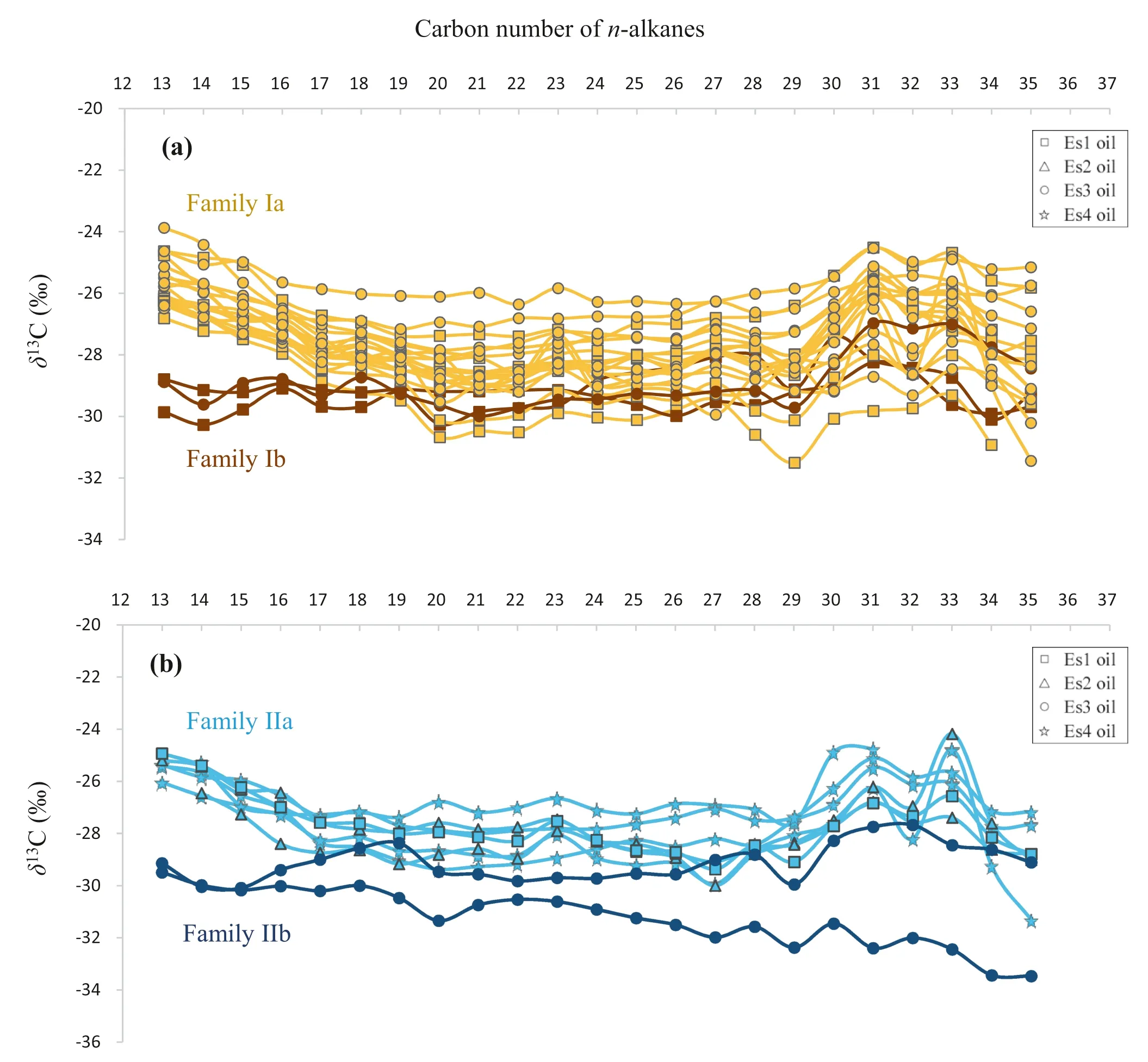
Fig. 5 The δ13C values of individual n-alkanes for the crude oils from the Shahejie Formation in the Zhanhua Depression: Family I (a) and Family II (b)
The long-chainn-alkanes are more stable than the bulk components of organic matters,so the δ13C value of oils is very conservative parameters to reflect the original organic facies (Liu et al. 2006a, b). The stable carbon isotopic value ofn-alkanes(n-C13-35)in the 31 crude oils from Es1to Es4members ranges from - 23.87 to - 33.46 ‰(Fig. 5).The average δ13C value ofn-alkanesin Family I is- 28.2 ‰, slightly lower than that of Family II, which is- 27.8‰.Both Family I and Family II oils can be divided into two subfamilies a and b based on distribution patterns of carbon isotopic value of then-alkanes. The δ13C has an average value of - 29.3 ‰ forn-C13-18and shows a ‘U’’pattern fromn-C13ton-C35in Family Ia,whereas the δ13C value has an average value of - 26.8 ‰ forn-C13-18and shows a flat pattern fromn-C13ton-C 35 in Family Ib(Fig. 5a).Then-C13-18show the lightest13C values in Family Ib, ranging from - 28.73 to - 30.27 ‰, which results in more negative13C values of Family Ib oils. In Family IIa, the overall pattern of the isotopic profile appears to be a ‘U’pattern,with an average δ13C value of- 27.6 ‰ forn-C13-35, slightly heavier than average δ13C value of - 30.2 ‰ in Family IIb oils (Fig. 5b).The13C value ofn-C13-35in Family IIb oils displays approximately a flat pattern, with an average δ13C value of - 30.17 ‰.Both carbon isotope ratios of then-alkanes of the oils from Family Ia and IIa are heavier than that of oils from Family Ib and IIb, indicating an increasing terrestrial organic matter input for Family Ia and IIa oils. Plank tonic algae has more negative13C values than that of terrestrial plants because concentrations of dissolved CO2are high in fluvial and lacustrine environments, and therefore more negative13C values may suggest a predominance of algal biomass,whereas more positive δ13C value may suggest the dominance of input higher terrestrial plants into organic matter(Hollander and Mckenzie 1991;Mayer and Schwark 1999;Sun et al. 2000).
3.4 Inferred source-rocks for the oil families
Previous studies have proposed that the Es1,lower Es3,and upper Es4are the main source rocks of oils in the Zhanhua Depression (Zhu 2002; Wang 2011; Song and Men 2019;Table 2). They have different hydrocarbon generation potential due to various types of organic matter (Wang et al. 2005, 2010). The upper Es4deposits exhibit a prominent advantage of phytane over pristane and have a relatively high abundance of gammacerane and C35homohopanes, with a ‘V’ pattern of C27, C28, and C29-ααα20R steranes.They were likely deposited in a brackish to a saline lacustrine setting (Table 2; Sun et al. 2015; Li et al. 2016; Song and Men 2019). However, the lower Es3deposits have a high Pr/Ph ratio and a low Ga/C30hopanes ratio, with an ‘L’ pattern of C27, C28and, C29ααα20R steranes. They were likely deposited in a freshwater lacustrine setting (Table 2;Sun et al.2015; Song and Men 2019). The Es1deposits have a low ratio of Pr/Ph and Ga/C30H, with the relative abundance of C28ααα20R steranes more than 30 %. They were likely deposited in a saline lacustrine setting (Table 2;Sun et al.2015; Song and Men 2019).In addition,organic matter of Es3and Es4is mainly mature, while the organic matter of the Es1is still in the stage of immature (Song and Men 2019).
In this study, low Pr/Ph and relatively high Ga/C30H ratiosin oils of Family I suggest the source rocks of the oils were probably derived from anoxic saline water conditions.High Ph/n-C18and low Pr/n-C17ratios of Family I in the ternary diagram of Pr/Ph, Ph/n-C18, and Pr/n-C17(Fig. 4a)suggest source rocks of Family I oils were likely originated from a brackish-saline lake. High Ph/n-C18and low Pr/n-C17ratios of Family I oils in cross plot of Pr/nC17versus Ph/nC18suggest source rock of Family I oils were likely developed in algal reducing environments (Fig. 4b). An extremely high ratio of hopane/sterane of Family I oils suggests strong bacterial input or bacterial modification of organic matter. A low ratio of C19/C23tricyclic terpane in Family I oils suggests a little contribution from terrestrial organic matter (Hanson et al. 2001). A high C35/C34hopane ratio in Family I suggests the source rocks of Family I may have been derived from highly reducing conditions.High ratios of C29sterane 20S/(20S+ 20R)and C29sterane αββ/(ααα + αββ) in Family I oils suggest the oils are thermally mature. The low Ts/(Ts + Tm) value in the Family I may suggest reducing depositional environments (Moldowan et al. 1986), considering all oils are thermally mature. Overall, geochemical characteristics of the Family I oils match that of source rocks in upper Es4perfectly and the interpretation of the depositional conditions, organic matter input, and maturity level are in consistent for both the oils and the source rocks.
Relatively high Pr/Ph and low Ga/C30H ratiosin Family II oils suggest the source rocks of Family II were probably derived from suboxic freshwater conditions.Low Ph/n-C18and high Pr/n-C17ratios of Family II in the ternary diagram of Pr/Ph, Ph/n-C18, and Pr/n-C17(Fig. 4a) suggest the source rocks of Family II oils were likely originated from a freshwater lake. Low Ph/n-C18and high Pr/n-C17ratios of Family II oils in cross plot of Pr/nC17versus Ph/nC18suggest source rock of Family II oils were likely developed in a transitional environment with mixed organic matter of algae and terrestrial higher plants(Fig. 4b).A high ratio of hopane/sterane suggests an important bacterial input or bacterial modification of organic matter. A high ratio of C19/C23tricyclic terpane in the Family II oils suggests an important contribution from terrestrial organic matter(Hanson et al. 2001; Volk et al. 2005). A low C35/C34hopane ratio in the Family II suggests the source rocks of Family II may have been derived from suboxic conditions.High ratios of C29sterane 20S/(20S+ 20R) and C29sterane αββ/(ααα + αββ) ratio in Family II oils suggest the oils are thermally mature.The high Ts/(Ts + Tm)value inthe Family II may suggest suboxic depositional environments (Moldowan et al. 1986), considering all Family II oils are thermally mature. Above all, geochemical characteristics and their interpretation of the Family II oils are inconsistent with that of source rocks in lower Es3.

Table 2 Diagnostic characteristics of the three main source rocks in the Zhanhua Depression
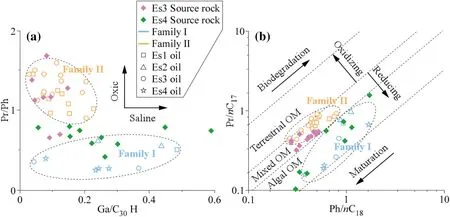
Fig. 6 Geochemical correlations for the oils and source rock samples:a Pristane/phytane ratio versus gammacerane/C30 hopane;b Pristane/nC17 ratio versus phytane/nC18 ratio. (Source rocks data originated from Liu et al. 2006a, b; Wang et al. 2010)
Based on the results and discussions above,we infer that Family I and II oils may have been derived from source rocks in upper Es4and lower Es3,respectively.The results also supported by comparing the data with source rocks in lower Es3 and upper Es4 respectively(Fig. 6,source rocks data originated from Liu et al.2006a,b;Wang et al.2010).
The stable carbon isotopic values of the two families are very similar to each other because they shared similar kerogen types of Type I and Type II1for the source rocks in Es4and Es1, respectively (Table 2). The stable carbon isotopic value of kerogen Type I is heavier than that of type II (Wang and Chen 2004).Thus, Family Ia and Family IIa oils were mainly controlled by the dominance of sapropelic matter input, while Family Ib and Family IIb oils were mainly originated from the humic substance. In summary,the subdivision of group a and b in Family I and II oils helps to better understand the process and mechanism of oil generation in a single family, and further assist in oil exploration.
4 Conclusion
Thirty-one crude oil samples in Shahejie Formation from in Zhanhua Depression,Bohai Bay Basin have been classified into two families on the basis of biomarkers and isotopic compositions. Family I oils are characterized by a low Pr/Ph value (<0.7), relatively high Ga/C30H and tricyclic terpane C22/C21ratio,and low C19/C23ratio.Family II oils are marked by a relatively high Pr/Ph value (0.7-1.6), low ratio of Ga/C30H and C22/C21tricyclic terpane,and a wide range of C19/C23ratio. The Family I oils are largely collected from Es2and Es4members and were likely originated from the upper Es4source rocks,while the Family II oils are largely collected from Es1and Es3members and were likely derived from the lower Es3source rocks. Both the Families I and II oils can be further subdivided into two groups by compound-specific carbon isotopic compositions ofn-alkanes.
AcknowledgmentsThanks to Dr. Yankuan Tian for GC-MS facilities and Dr. Zhao-wen Zhan of SKLOG for sample collection.This work was financially supported by the Chinese NSF Grants[41903064] to Hong Lu.
Compliance with ethical standards
Conflict of interestOn behalf of all authors, the corresponding author states that there is no conflict of interest.
杂志排行
Acta Geochimica的其它文章
- Late Ordovician mass extinction caused by global warming or cooling?
- In-situ LA-ICP-MS trace element and oxygen isotope signatures of magnetite from the Yamansu deposit, NW China, and their significance
- Geochemical constraints on the origin of Early Cretaceous alkaline intrusions and its tectonic implication, Sulu Orogenic Belt, Eastern North China Craton
- Hydrogeochemical characteristics of groundwater and quality assessment for the purposes of drinking and irrigation in Bougaa area, Northeastern Algeria
- Geochronology and geochemistry of magmatic rocks in the Dongzi-Changhanboluo Pb-Zn ore district in Chifeng,Inner Mongolia, and their relationship with metallogenesis
- Zircon U-Pb dating, geochemical, and Sr-Nd-Pb-Hf isotopicconstraints on the age and origin of intermediate to felsic igneous rocks at South Altyn, Xinjiang, China
